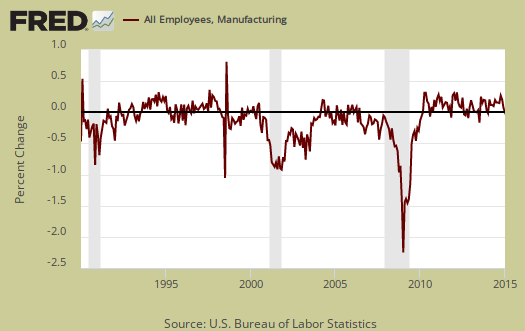The January ISM Manufacturing Survey shows manufacturing is still expanding, abet at an even slower pace than December. PMI dropped by -1.6 percentage points to 53.5% Everything was down this month, new orders especially declined. While technically not showing a contraction, the ISM overall message tells us American manufacturing is close to running idle. One month does not a trend make but this sure isn't a great start to the New Year for U.S. manufacturing.

This is a direct survey of manufacturers. Generally speaking indexes above 50% indicate growth and below indicate contraction. Every month ISM publishes survey responders' comments. In spite of the slowing growth manufacturer's comments are exceedingly positive. Three blamed workers which are slowing down the West Coast dock for better working conditions. Agriculture said demand for equipment is down.
New orders really plunged to mediocre growth. The -4.9 percentage point drop from last month gives a level of 52.9% as shown in the below graph.

The Census reported December durable goods new orders declined by -3.4%, where factory orders, or all of manufacturing data, will be out later this month, but note the one month lag from the ISM survey. The ISM claims the Census and their survey are consistent with each other and they are right. Below is a graph of manufacturing new orders percent change from one year ago (blue, scale on right), against ISM's manufacturing new orders index (maroon, scale on left) to the last release data available for the Census manufacturing statistics. Here we do see a consistent pattern between the two and this is what the ISM says is the growth mark:
A New Orders Index above 52.3 percent, over time, is generally consistent with an increase in the Census Bureau's series on manufacturing orders.

Below is the ISM table data, reprinted, for a quick view.
| ISM Manufacturing January 2015 | ||||||
|---|---|---|---|---|---|---|
| Index | December 2014 | January 2015 | % Change | Direction | Rate of Change | Trend Months |
| PMI™ | 55.1 | 53.5 | -1.6 | Growing | Slower | 20 |
| New Orders | 57.8 | 52.9 | -4.9 | Growing | Slower | 20 |
| Production | 57.7 | 56.5 | -1.2 | Growing | Slower | 11 |
| Employment | 56.0 | 54.1 | -1.9 | Growing | Slower | 19 |
| Supplier Deliveries | 58.6 | 52.9 | -5.7 | Slowing | Slower | 20 |
| Inventories | 45.5 | 51.0 | +5.5 | Growing | From Contracting | 1 |
| Customers' Inventories | 44.5 | 42.5 | -2.0 | Too Low | Faster | 2 |
| Prices | 38.5 | 35.0 | -3.5 | Decreasing | Faster | 3 |
| Backlog of Orders | 52.5 | 46.0 | -6.5 | Contracting | From Growing | 1 |
| Exports | 52.0 | 49.5 | -2.5 | Contracting | From Growing | 1 |
| Imports | 55.5 | 55.0 | -1.0 | Growing | Faster | 24 |
| OVERALL ECONOMY | Growing | Slower | 68 | |||
| Manufacturing Sector | Growing | Slower | 20 | |||
Production, which is the current we're makin' stuff now meter, dropped -1.2 percentage points to be 56.5%. Production usually follows incoming orders in the next month so we should expect production growth to slow down next month.

ISM's manufacturing production index loosely correlates to the Federal Reserve's industrial production, but not at 50% as the inflection point, instead 51.2% to indicate growth. Below is a quarterly graph of the ISM manufacturing production index (left, maroon), centered around the inflection point, quarterly average, against the Fed's manufacturing industrial production index's quarterly change (scale right, blue). We can see there is a matching pattern to the two different reports on manufacturing production.

The manufacturing ISM employment index is now 54.1% and decreased -1.9 percentage points from last month. This index really needs to be in the 60's to have real job creation and even though the growth accelerated it's still blasé. The neutral point for hiring vs. firing is 50.1%. Generally speaking manufacturing jobs have just been hammered going all the way back to the 1990's. Below are the BLS manufacturing non-farm payrolls (jobs) for the past decade on the left (maroon), graphed against the ISM manufacturing employment index on the right (blue). The BLS manufacturing payrolls is the monthly percentage change and the ISM manufacturing employment index is centered around it's inflection point of contraction and employment growth.

The inventories index contracted, which is somewhat bad news for economic growth. Inventories gives an estimate of how much raw materials manufacturers have on hand. They Jumped +5.5 percentage points to 51.0% and thus moved into expansion. Below is the relationship between BEA and ISM inventories, not the 50% inflection point one would assume.
An Inventories Index greater than 42.7 percent, over time, is generally consistent with expansion in the Bureau of Economic Analysis' (BEA) figures on overall manufacturing inventories.

Supplier deliveries are how fast manufacturers can get their supplies. A value higher than 50 indicates slower delivery times, a value below 50 means the supply chain is speeding up. The index decreased by -5.7 percentage points to 52.9%, which means a faster speed. You may wonder why slow deliveries would boost up PMI and indicate stronger growth in manufacturing. The reason is slower vendor performance means there is probably higher demand for that supply and thus indicates increasing activity.

Order backlogs decreased -6.5 percentage points to 46.0% and into contraction. More order backlogs would imply a need to ramp up even more production and (hopefully) more new employees to reduce them. This contraction is with wood products survey respondents reporting dock slowdowns are increasing their back orders.

Imports increased by +0.5 percentage points to 55.5%. Imports are materials from other countries manufacturers use to make their products and high levels isn't too great for economies of scale in the U.S. We want to see U.S. manufacturers use other U.S. manufactured materials instead of imports as much as possible. Yet another positive which is really a negative.

New orders destined for export, or for customers outside of the United States declined by -2.5 percentage point to 49.5% and moved into contraction. This is really not good and implies a global slowdown which will impact the U.S. economy.

Prices have really plunged on oil's slide and this month is no exception. Prices declined by -3.5 percentage points to 35.0%. Additionally the index has plunged by18.5 percentage points over the last three months. The price index hasn't been this low since April 2009 and this actually helps as the drop in energy prices drive down manufacturing costs. The ISM gives an index correlation to BEA price increases of 49.7%.

Customer's inventories decreased by -2.0 percentage points to 42.5%. Below 50 means customer's inventories are considered by manufacturers to be too low and this is a monthly change from about right. Customer inventories, not to be confused with manufacturer's inventories, are how much customers have on hand, and rates the level of inventories the organization's customers have.

Here is the ISM industrial sector ordered list of growth and contraction. Growth in printing is shocking as technological shifts have decimated that area.
Of the 18 manufacturing industries, 14 are reporting growth in January in the following order: Primary Metals; Wood Products; Printing & Related Support Activities; Miscellaneous Manufacturing; Fabricated Metal Products; Electrical Equipment, Appliances & Components; Petroleum & Coal Products; Paper Products; Transportation Equipment; Chemical Products; Machinery; Food, Beverage & Tobacco Products; Computer & Electronic Products; and Furniture & Related Products. The two industries reporting contraction in January are: Textile Mills; and Nonmetallic Mineral Products.
The ISM has a correlation formula to annualized real GDP, but they are now noting the past correlation, but note, PMI only has to be above 42.2% to indicate economic growth (right). Notice also that the PMI went to equal weighting in 2008. January alone gives a 3.3 % annual real GDP correlation. The below graph plots real GDP, left scale, against PMI, right scale, real GDP up to Q4 2014. One needs to look at the pattern of the two lines to get anything out of this by quarters graph. If they match, GDP goes up, PMI goes up, would imply some correlation.

The ISM manufacturing index is important due to the economic multiplier effect. While manufacturing is about an eighth of the economy, it is of scale and spawns all sorts of additional economic growth surrounding the sector.
The ISM neutral point is 50, generally. Above is growth, below is contraction, There is some some variance in the individual indexes and their actual inflection points. For example, A manufacturing PMI above 42, over time, also indicates growth, even while manufacturing is in the dumpster. Here are past manufacturing ISM overviews, unrevised. The ISM has much more data, tables, graphs and analysis on their website. PMI™ stands for purchasing manager's index. On ISM correlations to other indexes, when in dollars they normalized to 2000 values. The above graphs do not do that, so our graphs are much more rough than what the ISM reports these indices track.
Note: The ISM is seasonally adjusting some of these indexes and not others due to the criteria for seasonal adjustment. Those indexes not seasonally adjusted are: Inventories, Customers' Inventories, Prices, Backlog of Orders, New Export Orders and Imports.

Recent comments